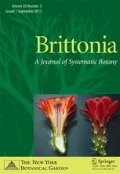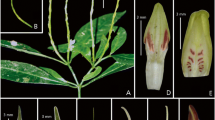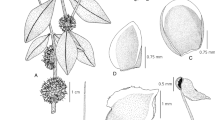Abstract
Carapa akuri, a new species endemic to central Guyana, is described and illustrated. It is compared to the two other species (C. guianensis and C. surinamensis) occurring in the Guianas.




Similar content being viewed by others
Literature Cited
Ek, R. 1997. Botanical diversity in the tropical rain forest of Guyana. Tropenbos-Guyana Series 4. University of Utrecht.
Engstrom, M. D., B. K. Lim & F. A. Reid. 1999. Guide to the mammals of Iwokrama. In association with the North Rupununi Development Board. Iwokrama International Centre, Guyana.
Fanshawe, D. B. 1947. Studies of the trees of British Guiana. I. (Carapa guianensis). Tropical Woods. 90: 30–40.
Forget, P.-M. 1996. Removal of seeds of Carapa procera (Meliaceae) by rodents and their fate in rainforest in French Guiana. Journal of Tropical Ecology. 12: 751–761.
Forte, J., S. Ousman & R. Radzik (eds.). 2002. Proceedings of the international technical workshop on sustainable and equitable marketing of crabwood oil in Guyana, November 23–24, 2002, Lake Mainstay Resort, Region 2, Guyana.
Funk, V., P. Berry, T. Hollowell, C. Kelloff & S. N. Alexander. 2007. Checklist of the plants of the Guiana Shield (Venezuela: Amazonas, Bolivar, Delta Amacuro; Guyana, Surinam, French Guiana). Contributions from the United States National Herbarium. 55: 1–584.
Gentry, A. H. 1988. New species and a new combination for plants from trans-Andean South America. Annals of the Missouri Botanical Garden 75: 1429–1439.
Gerard, J., R. B. Miller & B. J. H. ter Welle. 1996. Major timber trees of Guyana: timber characteristics and utilization. Tropenbos Series 15. The Tropenbos Foundation. Wageningen, The Netherlands.
Hammond, D. S. & V. K. Brown. 1995. Seed size of woody plants in relation to disturbance, dispersal and soil type in wet neotropical forests. Ecology. 76: 2544–2561.
———, S. Gourlet-Fleury, P. van den Hout, H. ter Steege & V. K. Brown. 1996. A compilation of known Guianan timber trees and the significance of their dispersal mode, seed size and taxonomic affinity to tropical rain forest management. Forest Ecology and Management 83: 99–116.
Hout, P. van der. 1996. Effects of logging with different intensities of low impact harvesting. Interim report. Tropenbos-Guyana Reports 96-1. Tropenbos-Guyana, Georgetown.
IUCN. 2001. IUCN Red List Categories and Criteria: Version 3.1. IUCN Species Survival Commission. IUCN Gland, Switzerland and Cambridge, United Kingdom.
Jansen, P. A., F. Bongers & L. Hemerik. 2004. Seed mass and mast seeding enhance dispersal by a neotropical scatter-hoarding rodent. Ecological Monographs 74: 569–589.
Jansen, P. A. & J. den Ouden. 2005. Observing seed removal: remote video monitoring seed selection, predation and dispersal. Pp. 363-378. In: P.-M. Forget, J. E. Lambert, P. E. Hulme, and S. B. Vander Wall (eds.), Seed fate: predation, dispersal and seedling establishment. CABI Publishing, Wallingford.
Kelloff, C. L. & V. A. Funk. 2004. Phytogeography of the Kaieteur Falls, Potaro Plateau, Guyana: floral distributions and affinities. Journal of Biogeography 31: 501–513.
Kenfack, D. 2008. Systematics and evolution of Carapa (Meliaceae-Swietenioideae). Ph.D. Thesis, University of Missouri, St. Louis. 237p.
Martinborough, T. 2002. Karaba oil (crabwood oil): a literature review. The Iwokrama International Centre for Rain Forest, Conservation and Development. Georgetown, Guyana.
Mennega, E. A., W. C. M. Tammens-de Rooij & M. J. Jansen-Jacobs. 1988. Check-list of woody plants of Guyana. Tropenbos Technical Series 2. The Tropenbos Foundation Ede, The Netherlands.
Noamesi, G. K. 1958. A revision of Xylocarpae (Meliaceae). Ph.D. thesis, University of Wisconsin, Madison.
Payne, K. 2001. The potential sustainable production of Carapa guianensis (Meliaceae) Aubl. oil in the Iwokrama Forest, Guyana. Faculty of Applied Sciences. University of Bristol, United Kingdom.
Polak, A. M. 1992. Major timber trees of Guyana: A field guide. The Tropenbos Foundation, Ede, The Netherlands
Rohlf, F. J. 1998. NTSYSpc: Numerical Taxonomy and multivariate System, ver. 2.02f. Exeter Publishing, Ltd.: Setauket, NY
Steege, H. ter. (ed). 2000. Plant diversity in Guyana, with recommendations for a national protected area strategy. Tropenbos Series 18. The Tropenbos Foundation, Wageningen, the Netherlands.
Styles, B. T. 1981. Swietenioideae. In: T. Pennington, B. T. Styles and D. A. H. Taylor. Meliaceae. Flora Neotropica Monograph 28: 1–470.
Thomas, R. S. 1999. Forest productivity and resource availability in lowland tropical forests of Guyana. Tropenbos-Guyana Series 7. Georgetown.
———. 2002. Flowering, fruiting and abundance of trees in Guyana. Pp. 17–23. In: J. Forte, S. Ousman, and R. Radzik (eds). Proceedings of the international technical workshop on sustainable and equitable marketing of crabwood oil in Guyana, November 23–24, 2002, Lake Mainstay Resort, Region 2, Guyana.
van Andel, T. 2000. Non-timber forest products of the North West District of Guyana. Part II: a field guide. Tropenbos Guyana Programme, Georgetown, Guyana.
Welch, I. A. 2002. Report on a forest inventory of the Conservation International Foundation (Guyana) Inc. State Forest Concession (FCA #01/2002) in the Upper Essequibo River. Unpublished.
Willis, F., J. Moat & A. Paton. 2003. Defining a role for herbarium data in Red List assessments: a case study of Plectranthus from eastern and southern tropical Africa. Biodiversity and Conservation 12: 1537–1552.
Acknowledgments
We are thankful to the Guyana Forestry Commission, Georgetown, which granted permission for field expeditions to Mabura and Pibiri forests. Pierre-Michel Forget was granted by Plan Pluri-Formation “Ecologie fonctionnelle et développement durable” at Muséum National d’Histoire Naturelle and by UMR 7179 CNRS-MNHN. We thank Janet Forte and Sharon Ousman from the Iwokrama International Center for their invitation to participate in the Workshop in Guyana, and for facilitating PMF’s first trip to Iwokrama forest in November 2002. We thank Harry Benedict who assisted our climbing for the voucher collections, and Waldyke Prince for his help at the Iwokrama Field Station. We are also indebted to Doorjohan Gopaul for his help while visiting the National Herbarium and Centre for the Study of Biological Diversity at University of Guyana, Georgetown. We thank the curators of the following herbaria for allowing access to their collections: BRG, CAY, GU, P, and US. Thanks to Douglas Daly and Scott Mori for comments and help at various stage of the review process. We are also indebted to Patrice Mutchnick, Vicki Funk, and Sara Alexander for valuable information about locality data from vouchers at US. Finally, we are thankful to Jewel Liddell at The University of Guyana National Herbarium for help with the export procedure, and to Dr. Indarjit Ramdass at the Environmental Protection Agency of Guyana for giving us permissions to conduct biodiversity research on “Diversity of Crabvwood species in South America” (EPA permission No. 211105 BR042) and to export vouchers (EPA permission No. 011205 SP: 008) to France, and to Dominique. Storez who prepared Fig. 1.
Author information
Authors and Affiliations
Corresponding author
Appendix
Appendix
Rights and permissions
About this article
Cite this article
Forget, PM., Poncy, O., Thomas, R.S. et al. A new species of Carapa (Meliaceae) from Central Guyana. Brittonia 61, 366–374 (2009). https://doi.org/10.1007/s12228-009-9090-z
Published:
Issue Date:
DOI: https://doi.org/10.1007/s12228-009-9090-z




